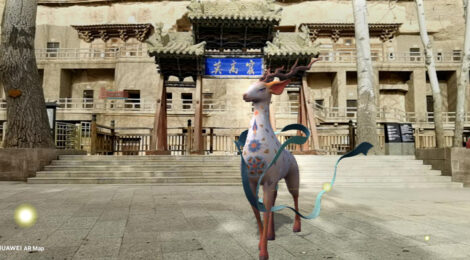
Dunhuang smart destination and cooperation with Huawei
Smart tourism destinations in China
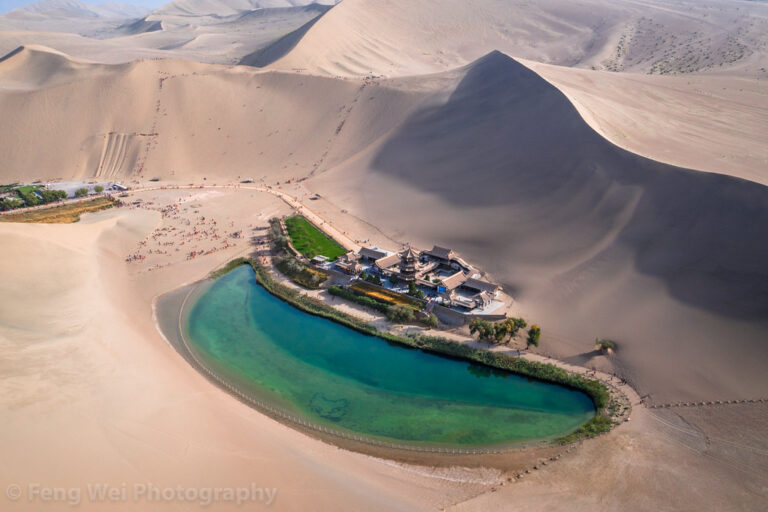
Vibes of the Ancient Silk Road – Fascinating “Crescent Lake ” near Dunhuang.
In China (as everywhere else in the World) we are witnessing a crucial moment for the tourism sector. The role of smart tourism platforms and smart services such as online ticket purchase, face entry, and self-guided tour could be a way out to strengthen national tourism and make it accessible despite pandemic restrictions before the mass spread of the vaccine in the country.
It is foreseeable that the implementation of more smart tourism technologies reservation system and an increase in the customization of tourist products will become the new normal of tourism consumption in the future in China.
For tourist destinations, providing good products and good services will no longer be the only requirement. It will be more important for visitors to feel safe while watching beautiful sceneries. Safety, sustainability of the tourism environment, and service quality of tourist destinations will have a key impact on tourists’ decisions, and new tourist safety concepts for Chinese tourists will gradually take shape.
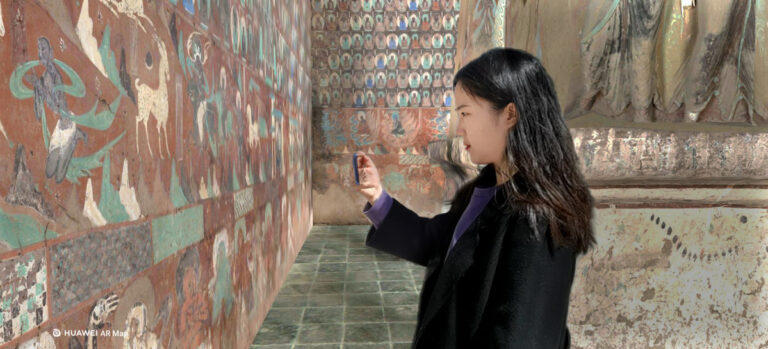
A visitor experiences the Hetu artificial intelligence platform during a tour of Cave 257 in Mogao
The case of the city of Dunhuang
The city of Dunhuang is located in the Chinese province of Gansu, in northwestern China. It is more than 2100 kilometers away from our Chongqing headquarters, and it takes 22 hours of driving to get there by car. Dunhuang was a destination on the “Ancient Silk Road”. It was founded as a military outpost in 111 BCE to guard the northwest frontier against nomad raiders and to protect and regulate trade routes.
As written by Demas, Agnew and Fan (2015), the ancient name itself reflects this: Dunhuang means “Blazing beacon”, referring to the string of watchtowers to the north and west that served to spread the alarm by lighting bundles of dry brush at the approach of the nomad enemy. By the late fourth century Dunhuang had become an important oasis and trading center. It was nearby that the wandering Buddhist monk, Yuezu, had a vision of excavating the first cave in a cliff face about the Daquan River, in what was to become the Mogao Grottoes. Hundreds of caves, some quite large, some mere niches, were excavated and decorated with brilliant wall paintings and sculpture”.
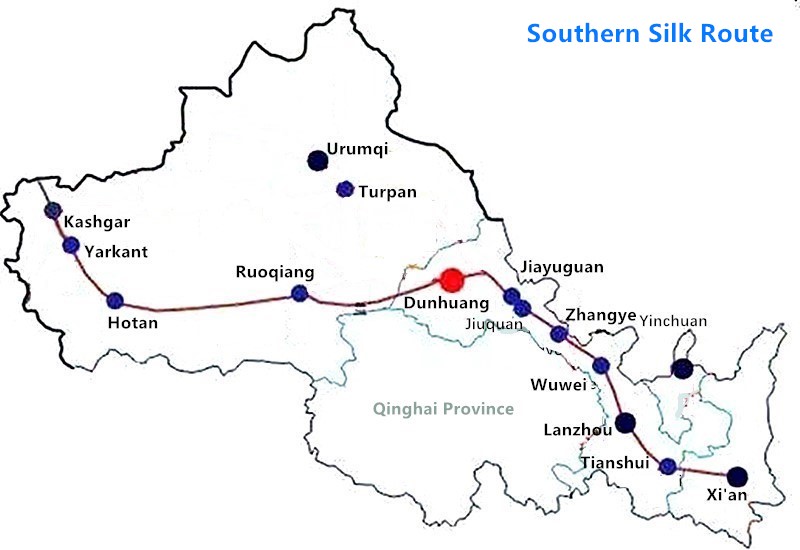
Southern Silk Road
Today Dunhuang is a thriving, tourism driven city, small by Chinese standards with a population of around 200.000, having grown rapidly from a small agricultural town largely as a result of expanding tourism to the Mogao Grottoes, and spurred by the influx of development funding from government and private sources. This tourism destination can well represent the renewed interest of Chinese leadership in creating experiences of “cultural tourism”. At the same time, leaders add a new step to update Chinese tourism destinations to a “New Era”, investing in smart technologies with the help of national tech giants. And the pandemic has accelerated trends in tourism and the need to implement technological alternatives to support the tourism sectors.
This little internationally known Chinese city has focused its efforts on “smart destination” technologies that manage urban infrastructures, planning transport and ensuring public safety. This is seen as a response to over tourism and the large tourist masses that can ruin its old sites. Before the outbreak of the pandemic, tickets were booked online, visitors could access the sites using a QR code, thanks to the cloud access system. Facial recognition and fingerprints were also used and its role was skyrocketing.
For this reason, thanks to the use of new technologies to monitor tourist flows, but which can also be used to facilitate the daily life of its inhabitants, Dunhuang has thus become not only a “smart destination”, but also a “smart city”.
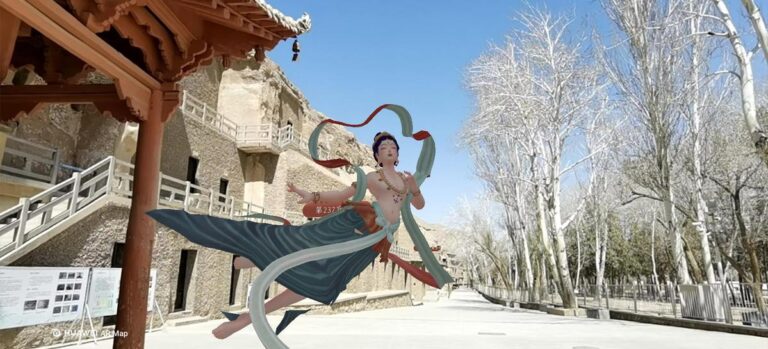
Flying Apsaras brought to life thanks to technology
The cooperation with Huawei
To improve its technology level, face new challenges and solve annual problems related to over tourism, the city of Dunhuang in the past years has signed a cooperation agreement with Chinese tech giant Huawei.
Huawei was chosen to build the “Feitian Cloud Data Center”, thanks to its experience in the fields of cloud computing, big data, internet of things, mobile internet and artificial intelligence. Under the agreement, the center has implemented nine platforms covering aspects of family life, transportation, travel, healthcare, education and public information.
Technologies are also used to promote the safety of the city. Dunhuang has launched a “Safe city project” with the collaboration of the “national champion”, integrating the functions of real-time monitoring, audio retrieval, voice intercom, digital map and data storage.
More recently, new technologies have favored the development of local tourism during the pandemic. Dunhuang Academy and Huawei launched a virtual tour of the Mogao Caves last April. Using the “Hetu artificial intelligence platform“, visitors were able to enjoy an immersive experience outside the caves.
Using a Huawei phone model, visitors were able to observe the details of the murals outside the cave, aiding the protection of the cultural relics, while at the same time helping to increase the amount of information visitors can obtain.
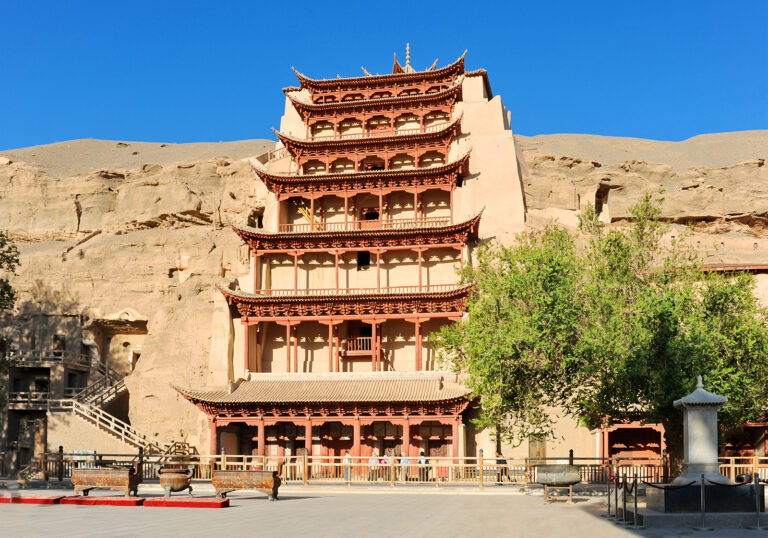
Entrance to Mogao Caves, 25 km far from Dunhuang city center
On the night of April 15, 2020, the “Dunhuang super perception image” show was launched jointly by Zhao Shengliang, President of the Dunhuang Research Institute, and Cai Zi, the host of the event. The technologies of 5g, AI, VR were used. Using the “Huawei River” map, visitors with their Huawei models were able to experience an “immersive” visit outside the caves.
The Huawei AR map is based on Huawei’s Cyberverse technology and is dedicated to creating an “earth-level, evolving, new digital world that seamlessly integrates with reality.”
As underlined by Kamlesh Bhati, “the boundary between the digital virtual world and the real world is lost, the entire real world becomes a panel for information display, and various real-time information is superimposed and displayed in the real environment where you are currently, allowing you to easily find the legendary net red Punch points, recent toilets, and interesting stories that happened in space and time. The whole real world becomes a paradise where games can be played. The real world is the birthplace of your endless fun”
With the capabilities of Hetu, Huawei has also carried out a series of algorithms and technical optimizations on the AR map released this time to achieve full-scene centimeter-level space calculations and make positioning more accurate.
At the same time, combined with large-scale environment recognition and virtual and real fusion algorithms, Huawei AR Maps can show users some virtual 3D images and expand their cognitive scope.
Written by Marco Bonaglia
RESOURCES
Demas M., Agnew N. and Fan Jinshi (2015), Strategies for sustainable tourism at the Mogao Grottoes of Dunhuang, China, Springer. London and New York
Richard Whiddington (2019), Weibo Data Shows Cultural Tourism on the Rise, https://jingculturecommerce.com/weibo-data-chinese-cultural-tourism-growing/
Xu Shenglan, Xue Hua (2018), Dunhuang: On the Silk Road with smart tourism and big data, https://www.huawei.com/it/publications/winwin-magazine/31/dunhuang-new-experience-of-smart-travel
Guangzhouaward.org (2018), Digital Silk Road, smart Dunhuang, http://subsites.chinadaily.com.cn/guangzhouaward/en/2018-02/22/c_145969.htm
Dayday News (2020), Huawei River Map: 5G smart perception through history, https://daydaynews.cc/en/technology/497743.html
Kamlesh Bhati (2020), Huawei AR Map Live Demo; Digital World That Seamlessly Integrates With Reality, https://sparrowsnews.com/2020/04/08/huawei-ar-map-live-demo/




